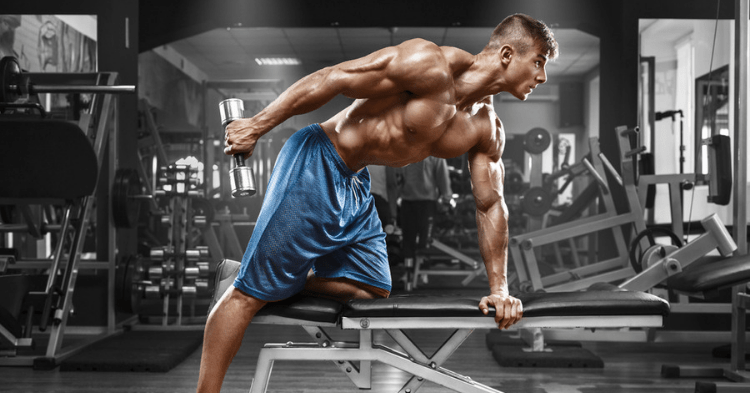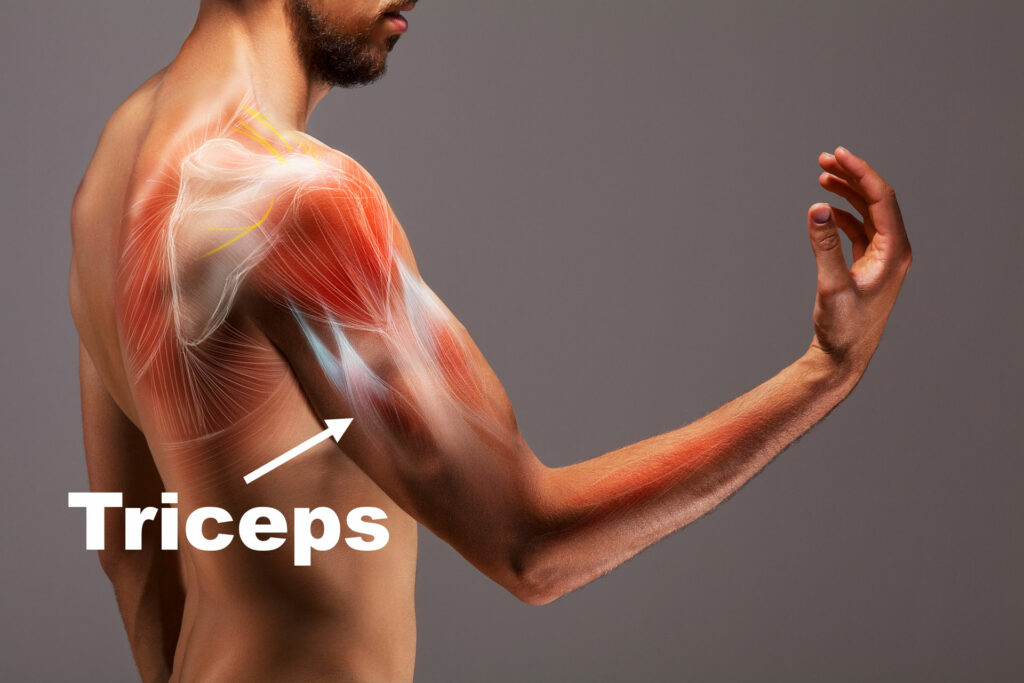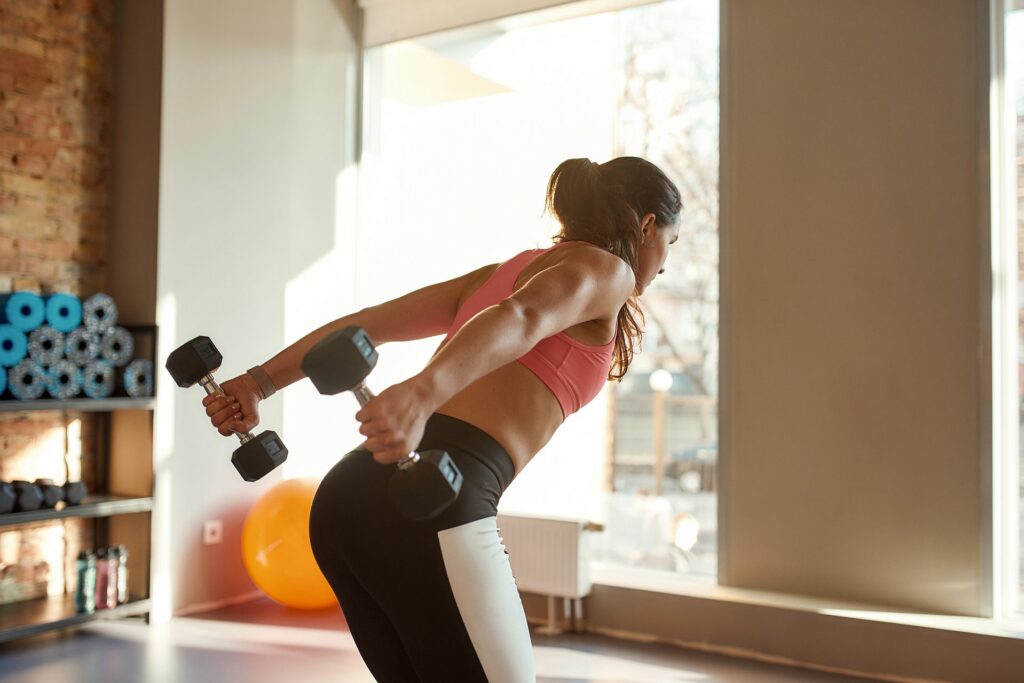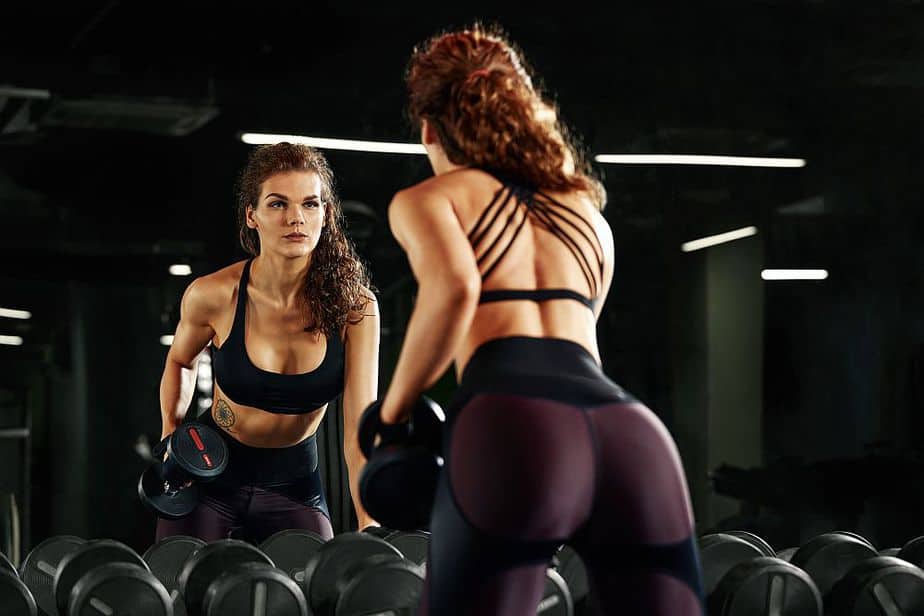Dumbbell tricep exercises are highly effective at targeting and strengthening the tricep muscle, which is located on the back of the upper arm. These exercises can be done using a variety of different dumbbell movements, such as overhead extensions, kickbacks, and close-grip presses. They are versatile, easy to learn and can be easily modified to suit a wide range of fitness levels. Incorporating dumbbell tricep exercises into a regular workout routine can help to improve upper body strength, tone the triceps, and even increase overall athletic performance.

Often, in our quest for bigger, more shapely arms, our biceps get given all the attention. Given that our triceps are the larger muscle group out of the two, taking up a greater space on our arms, this is a very backward approach. In this article, I’m going to help you get to know your triceps better.
I’ll be covering some basic tricep anatomy as well as 9 of the best dumbbell tricep exercises you can do anywhere and anytime. And for extra measure, I’m going to share with you the most effective way to integrate tricep training into your weekly workout regime.
Contents
- What are triceps?
- 9 tricep dumbbell exercises
- How can you add tricep exercises with dumbbells to your workout?
- Tricep workouts with dumbbells: Conclusion
What are triceps?
The triceps brachii is one of the largest muscles in our upper arm, located at the back of the arm. Our triceps have two main functions – the retraction and extension of the elbow joint and assisting in the stability of the shoulder joint.

Our triceps are split into three sections, often referred to as our ‘tricep heads’:
- Long head (the largest part)
- Lateral head (the medium-sized part)
- Medial head (the smallest part)
When it comes to training triceps, for best results in overall functionality and aesthetics, it is important to perform a range of exercises that hit all three sections of the muscle.
Some of the benefits that can be experienced through having strong and well-conditioned triceps are:
- Enhanced upper body performance, specifically in your heavier lifts.
- Increased shoulder stability, which equates to a decreased chance of injury.
- Fuller, more shapely-looking arms.
- Muscular symmetry (biceps to triceps ratio)
9 tricep dumbbell exercises
Whilst there are a variety of tricep exercises that use a range of equipment and machines, the following 9 exercises require dumbbells only. As a result, tricep dumbbell exercises are very accessible as they can be performed from the comfort of your home gym or as part of broader tricep muscle workouts, and not at the expense of your tricep gains!
1. Single Arm Tricep Kickback (Bench Supported)

Exercise highlight: unilateral tricep isolation!
Let’s start with this tricep classic – the single-arm tricep kickback.
There are several variations of this exercise, which I will get into further on. But this one is a great starting place. As it is a bench-supported exercise, you have that extra stability provided. This combined with the fact that you’re using one arm at a time means you can isolate the load onto each of your triceps, one at a time.
To do it:
The single-arm tricep kickback exercise has you kneeling on the bench and supporting your upper body with your non-working arm and knee. Your body should be in a tabletop (flat back) position. Start with a dumbbell in one hand and your upper arm in line with your back.
Extend at the elbow until your arm is fully straightened, contracting your triceps. Then slowly return to a rough 90-degree bend at the elbow before performing your next repetition.
Exercise tips:
- Don’t let the elbow of your working arm drop during your reps. Keep your arm in line with your back/torso.
- The eccentric phase of the exercise (returning to a bent elbow position) should be slow and controlled.
2. Bent Over Tricep Kickbacks

Exercise highlight: great for developing tricep strength.
Bent over tricep kickbacks are a good go-to exercise if you’re looking to strengthen and tone your triceps. Very similar to the single-arm bench-supported kickback as described above, but different in that you’re supporting your own body as opposed to using a bench.
For the purpose of this article, the bent-over tricep kickback I’m referring to is done with both arms at the same time. However, if you’re a unilateral exercise enthusiast, this one can be performed in a single-arm fashion too!
To do it:
Start with a dumbbell in each hand and your feet hip-width apart. Hinge forward at the hips until your torso is just off parallel to the ground. Have your elbows bent and upper arms in line with your torso. Extend at the elbow until both arms are straight and then return slowly to starting position.
Exercise tips:
- Hold for two seconds once your arms are extended and your triceps are fully contracted.
- Avoid lifting your chest or any other part of your body – only your arms, from the elbow down, should be moving. No swing!
3. Incline Kickbacks (Tricep Workouts for Women)

Exercise highlight: particularly effective for hitting the long head of the triceps.
The long head of your triceps is the most predominant section of the muscle, especially from a visual perspective. Incline kickbacks provide the opportunity for the long head to be under maximum tension, over the medial and lateral heads. If body shaping is your thing, you’ll love this one.
To do it:
Support your body face down on an incline bench set at around 45-degrees. Like all other versions of the kickback, your starting position should see you bent at the elbow with your upper arm in line with your torso. Once you have extended at the elbow, your upper and lower arm should be in line with your body.
You can, of course, do this exercise in a unilateral way. However, I find the double-sided version most effective for this one.
Exercise tip:
- Be mindful of the weight you choose – start light and build up from there. Going too heavy will encourage your arms to drop as you fatigue, which makes this exercise much less effective.
4. Close Grip Dumbbell Press

Exercise highlight: it’s a compound exercise that places less stress on the elbows.
The close grip dumbbell press works your chest and shoulders too, though your triceps are the primary working muscle and the driving force behind this compound push exercise. As it’s a multi-joint movement, you can load this exercise more. This makes it optimal for building those strength gains!
To do it:
Lie flat on a bench with a dumbbell in each hand on fully extend arms above your chest. Your arms should be stacked on top of your shoulders and your palms should be facing each other. Lower the dumbbells down by bending at the elbows. The end of the movement should see you with your elbows bent at 90-degrees and close by your sides.
From here, push back up until your arms are fully extended again above your chest. These can be done with both arms at the same time, alternating from left to right arm, or with one arm at a time.
Exercise tips:
- Avoid too much flexion through the wrists, under the dumbbells.
- Watch that your elbows are not getting placed further away from your sides with each repetition, as your triceps fatigue and you try to compensate with chest strength.
- Make sure your feet are on the floor and not on the bench, to protect your lower back.
5. Skull Crushers

Exercise highlight: will increase lockout strength which is especially beneficial for power/heavy lifters.
Don’t let the name put you off! This is one of my favorite single-joint exercises to incorporate into my triceps training regime. Depending on how you approach this exercise, in terms of the weight used and repetitions performed, it can be beneficial in developing both strength and hypertrophy.
To do it:
Lie flat on a bench with a dumbbell in each hand and your feet flat on the floor. You should begin with your arms extended in a straight line from your shoulders, upwards. From here, by bending at the elbow only, lower the dumbbells down to either side of your head. Once the dumbbells reach your ears (or around there), push the dumbbells back up until your arms reach full extension/elbow lockout.
Exercise tips:
- Keep elbows tucked in – avoid flaring out.
- Ensure there is no movement through the shoulder joint, which will keep your upper arm fixed in place and appropriately load your triceps.
6. Close Grip Dumbbell Push Ups

Exercise highlight: increased range of motion in comparison to the standard tricep push up and, therefore, better engagement!
We recommend using rubber hex dumbbells for this exercise.
Whilst you’re not pushing or pulling the dumbbells in this exercise, using them in a stationary position as your base allows for a more significant push up range. You may associate push ups with working your chest, however, altering the positioning of your hands and adding dumbbells can help shift a lot of the load onto your triceps.
To do it:
Start in tabletop plank position with a hand on each one of the dumbbells. The dumbbells should line up directly under your shoulders, and your palms should be facing each other, i.e. a ‘narrow grip’ position. From here, lower your body down towards the ground by bending at the elbows. Your elbows should skim past your sides rather than flaring outwards.
If the “full” version of this exercise is beyond your current strength capabilities, you can do a modified version on your knees instead of on your toes.
Exercise tips:
- Don’t sag through the hips. Keep your core engaged and hips tucked under to keep your lower back safe.
- Lower yourself down into the push up over a few seconds and then push back up to starting position with a bit more power.
7. Tate Press

Exercise highlight: a unique and challenging exercise for the advanced lifter, that triggers tricep development.
This exercise looks weird. It is weird. However, it’s also very effective. It’s not easy to perform so it’s one for the more seasoned lifter. The Tate press is most like the skull crusher but follows a horizontal positioning of the arms to the body, rather than a vertical positioning, as seen in the skull crusher.
To do it:
Set up as you would for a dumbbell bench press, lying flat on a bench with a dumbbell in each hand and your arms fully extended above your chest. From here, you’re going to bend at the elbows, moving the dumbbells inwards, and downwards towards your chest. The dumbbells should just touch your chest, but not rest on your chest, before you lift them up until your arms are fully extended again.
Give your triceps a good squeeze at the top whilst they are fully contracted before going into your next repetition.
Exercise tips:
- Start with light weights and only increase once you have mastered the movement.
- Keep your repetitions slow and controlled throughout.
8. Seated Dumbbell Tricep Extensions

Exercise highlight: all three of the tricep heads get flexed and stretched in this movement.
This exercise can be done standing too. The seated version offers the support of a bench which is optimal for those with lesser core strength or those with a greater focus on strength development as opposed to mass gains. The added support of the bench may allow you to lift more weight.
To do it:
Begin seated on a bench with a single dumbbell held between your hands. Raise your arms (and the dumbbell) above your head and then bending at your elbows, lower the dumbbell behind your head to form a 90-degree bend at the elbows. Hold here for a second and then push back up to starting position.
The 90-degree bend in your elbows once the dumbbell is lowered behind your head is not gospel – should you wish to lower the dumbbell beyond this angle at the elbows, you can do so. The further you lower the dumbbell, the more stretch through the triceps. This can increase your ability to gain mass through this exercise.
Exercise tips:
- Keep your elbows tucked in. Avoiding flaring out will protect your elbows from injury and load your triceps more effectively.
- Hold the dumbbell by placing the palms of your hands under the top part of the dumbbell for a solid grip that doesn’t require squeezing the dumbbell. The squeeze creates tension through your hands and wrists and takes away from your triceps.
9. Standing Single Arm Tricep Extensions
 &t=60s
&t=60s
Exercise highlight: it requires a lot of stability (from your whole body), and specifically challenges the stability of your shoulder girdle.
The more challenging version of the seated overhead tricep extensions, this standing unilateral version will help build equal strength and size through your triceps. This exercise does lend itself to injury if not performed correctly so make sure you watch the demo video and adhere to the technique notes below.
Any exercise that sees you standing with weight-loaded overhead requires a great deal of core control as to not hurt your lower back. Keep your glutes ‘on’ and hips tucked throughout to avoid hyperextension through your lower back.
To do it:
Start by standing with your feet shoulder-width apart and holding a dumbbell in one hand with a pronated grip. Your non-working hand can be by your side or on your hip. Lift your arm up overhead and go into starting position, which is with your elbow bent and the dumbbell lowered behind your head. Push the dumbbell back upwards above your head until your arm is fully extended, and your elbow is locked out.
Exercise tips:
- Don’t lean back through your thoracic under the load of the dumbbell.
- Your elbow should be pointing closer to the front of your body rather than the side of your body for optimal tricep load and lesser chance of injury.
How can you add tricep exercises with dumbbells to your workout?
So, now that you know about a bunch of great tricep exercises that can be done with dumbbells, let’s look at the best strategy for implementing them!

Compound Tricep Exercises vs. Isolation Tricep Exercises
Triceps respond best to compound exercises. That’s not to say that isolated tricep exercises aren’t good for them – they are! But, in terms of prioritizing one over the other, your compound tricep exercises should come first in line on the day that you are working your triceps.
Why? The effectiveness of muscular overload stimulation in compound exercises for triceps is significantly higher than in the isolation exercises, through which you can load the triceps a lot less. Your tricep work should include isolation exercises, but they should come after your compound movements.
More on this: Do These 7 Compound Exercises for Bicep and Tricep Gains
When should you train triceps?
The way in which you approach your tricep training will depend on what your weekly workout regime looks like and what your ultimate training goals are. Here are a few options:
If you’re making use of a push/pull & legs approach – place emphasis on your triceps on your push day. This can be done by including more tricep exercises or increasing the number of tricep sets you do. You can also include a few tricep exercises on leg day.
If you follow a full-body weekly workout regime – include some tricep work on each workout day, in and amongst your other muscle group exercises. You can also do the variations of other exercises that have more of a focus on your triceps, for example, narrow grip dumbbell push ups instead of regular push ups.
And finally, if you’re more into the muscle group split training over a 4-day or 5-day plan – aim to get in at least two days where your focus is on your upper arms. And the general rule of thumb on these days should be tris before bis!
Tricep workouts with dumbbells: Conclusion

There are so many tricep workouts with dumbbells that can be done and some of the best ones are the ones with dumbbells. Dumbbells create ” equal opportunity” for your left and right sides and help you build equal strength and a nice symmetrical aesthetic through your upper arms.
Ultimately, it’s great to have variety in your workouts and use a bunch of machines and equipment. But, that’s not to say that you CAN’T get in a well-rounded tricep workout using dumbbells only! So, if that’s all you have access to – no stress!
I hope these tricep workouts with dumbbells have you feeling well equipped and in the know when it comes to your triceps. Now all you must do is put some of these exercises to practice by integrating them into your workout regime, smartly, as you now know how!